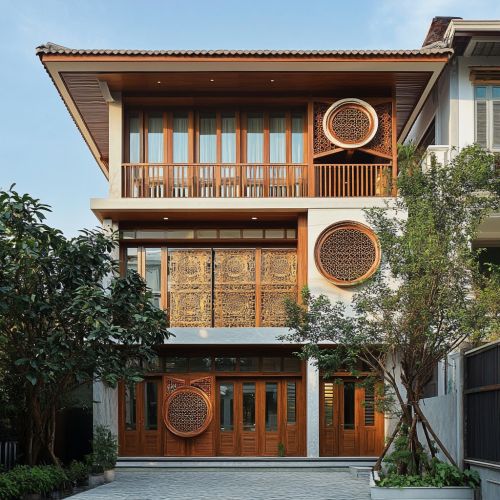Ngô Viết Thụ: Difference between revisions
(Created page with "== Early Life and Education == Ngô Viết Thụ was born on September 17, 1926, in Thừa Thiên-Huế Province, Vietnam. He grew up in a period marked by significant political and social changes in Vietnam, which was then under French colonial rule. Thụ's early education took place in Vietnam, where he demonstrated a keen interest in architecture and design. His talent and dedication earned him a scholarship to study in France, a pivotal moment that would shape his...") |
No edit summary |
||
| Line 11: | Line 11: | ||
One of Thụ's core philosophies was the importance of context in architecture. He believed that buildings should not only serve their functional purposes but also enhance their surroundings and reflect the cultural identity of their location. This approach is evident in many of his projects, where he carefully considered the environmental, cultural, and historical context of each site. | One of Thụ's core philosophies was the importance of context in architecture. He believed that buildings should not only serve their functional purposes but also enhance their surroundings and reflect the cultural identity of their location. This approach is evident in many of his projects, where he carefully considered the environmental, cultural, and historical context of each site. | ||
[[Image:Detail-98415.jpg|thumb|center|A modern Vietnamese building designed by Ngô Viết Thụ, featuring traditional motifs and contemporary elements.]] | |||
== Notable Works == | == Notable Works == | ||
Revision as of 23:25, 10 October 2024
Early Life and Education
Ngô Viết Thụ was born on September 17, 1926, in Thừa Thiên-Huế Province, Vietnam. He grew up in a period marked by significant political and social changes in Vietnam, which was then under French colonial rule. Thụ's early education took place in Vietnam, where he demonstrated a keen interest in architecture and design. His talent and dedication earned him a scholarship to study in France, a pivotal moment that would shape his career and influence his architectural style.
In France, Thụ attended the prestigious École des Beaux-Arts in Paris, one of the most esteemed institutions for architecture in the world. He studied under the tutelage of renowned architects and was deeply influenced by the Beaux-Arts architectural style, which emphasized classical design principles, symmetry, and grandeur. Thụ's education at École des Beaux-Arts provided him with a solid foundation in architectural theory and practice, which he would later integrate with traditional Vietnamese elements in his work.
Architectural Philosophy and Style
Ngô Viết Thụ is best known for his unique architectural style that blends Western modernism with traditional Vietnamese aesthetics. His work reflects a deep understanding of both cultures and an ability to harmonize them in a way that respects the past while embracing the future. Thụ's designs often incorporate elements such as traditional Vietnamese motifs, materials, and spatial organization, which he skillfully combines with modern architectural techniques.
One of Thụ's core philosophies was the importance of context in architecture. He believed that buildings should not only serve their functional purposes but also enhance their surroundings and reflect the cultural identity of their location. This approach is evident in many of his projects, where he carefully considered the environmental, cultural, and historical context of each site.

Notable Works
Ngô Viết Thụ's architectural legacy is marked by several iconic projects that have left a lasting impact on the architectural landscape of Vietnam and beyond. Some of his most notable works include:
Independence Palace
Perhaps the most famous of Thụ's works is the Independence Palace, also known as the Reunification Palace, located in Ho Chi Minh City. Completed in 1966, the palace served as the presidential residence and workplace of the President of South Vietnam during the Vietnam War. The design of the palace is a testament to Thụ's ability to merge modernist architecture with traditional Vietnamese elements. The building features a harmonious blend of open spaces, natural light, and traditional motifs, making it a symbol of Vietnam's architectural identity.
Đà Lạt University
Another significant project by Ngô Viết Thụ is the Đà Lạt University campus, located in the Central Highlands of Vietnam. The campus is renowned for its integration with the natural landscape, featuring buildings that complement the surrounding pine forests and rolling hills. Thụ's design emphasizes the use of local materials and traditional architectural forms, creating a serene and conducive environment for education.
Other Projects
In addition to these landmark projects, Thụ was involved in numerous other architectural endeavors, both in Vietnam and internationally. His work includes residential buildings, public spaces, and cultural institutions, each reflecting his commitment to creating architecture that is both functional and culturally resonant.
Influence and Legacy
Ngô Viết Thụ's influence on Vietnamese architecture is profound. He is credited with pioneering a modern architectural movement in Vietnam that respects and incorporates traditional elements. His work has inspired a new generation of architects who continue to explore the possibilities of blending modernity with tradition.
Thụ's legacy extends beyond his architectural achievements. He was also an educator and mentor to many young architects, sharing his knowledge and passion for design. His contributions to architectural education have helped shape the future of architecture in Vietnam and beyond.
Awards and Recognition
Throughout his career, Ngô Viết Thụ received numerous awards and honors for his contributions to architecture. In 1955, he was awarded the Grand Prix de Rome, a prestigious accolade that recognized his exceptional talent and potential. This award provided him with the opportunity to further his studies in Italy, where he continued to refine his architectural philosophy.
Thụ's work has been celebrated in various exhibitions and publications, both in Vietnam and internationally. His designs are studied and admired for their innovative approach and cultural sensitivity, cementing his status as one of Vietnam's most influential architects.
